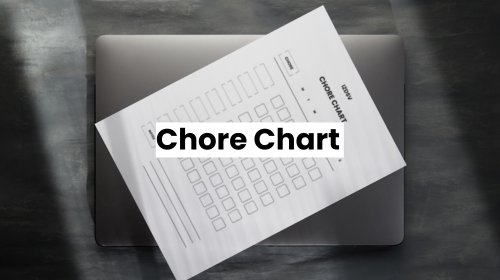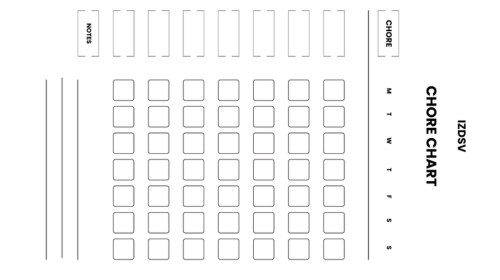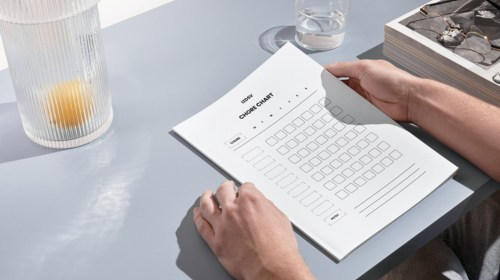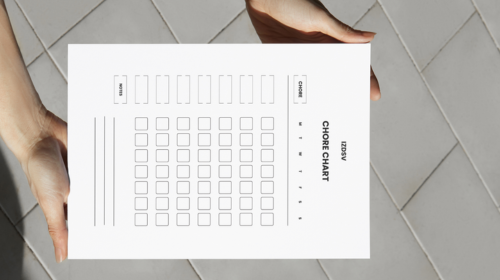Best Minimalist Chore Chart Designs: Printable & Digital Templates for Your Family
Introduction to Minimalist Chore Charts
Minimalist chore charts represent a streamlined approach to household task management that focuses on simplicity and clarity rather than complex systems. They eliminate visual clutter and unnecessary elements to create a clean, functional tool that everyone in the household can easily understand and use.
- Strip away decorative elements and focus purely on essential information
- Use clean lines, simple fonts, and plenty of white space
- Emphasize functionality over aesthetic embellishment
- Create systems that are easy to maintain and update
- Reduce cognitive load by presenting information clearly and concisely
What is a Minimalist Chore Chart?
A minimalist chore chart is a simplified organizational tool that displays household tasks using only the most essential visual elements and information. It typically features clean typography, basic colors, and straightforward layouts without decorative graphics or complex tracking systems.
- Contains only necessary information like task names, assigned person, and completion status
- Uses simple color coding or checkboxes rather than elaborate reward systems
- Features a clean, uncluttered design with plenty of negative space
- Focuses on core functionality without unnecessary visual elements
- Often uses neutral colors and basic geometric shapes
- Eliminates complex charts, graphs, or tracking mechanisms
- Prioritizes readability and quick comprehension
Benefits of Using a Minimalist Design
Minimalist chore charts reduce visual overwhelm and make it easier for family members to process and act on the information presented quickly. This simplified approach often leads to better compliance and less resistance to using the system consistently.
- Reduces decision fatigue by presenting clear, simple choices
- Easier to maintain and update without complex formatting
- Less intimidating for children and reluctant participants
- Faster to scan and understand at a glance
- More likely to be used consistently due to simplicity
- Saves time in creation and maintenance
- Works well in any home decor style without clashing
- Focuses attention on completing tasks rather than managing the system
- Reduces stress associated with overly complicated organizational tools
- More adaptable to changing household needs and routines
Types of Minimalist Chore Chart Designs
Minimalist chore chart designs come in several distinct formats, each tailored to different household preferences and organizational styles. The most common types include simple grid layouts, weekly planners, daily task lists, and rotating responsibility charts that maintain clean aesthetics while maximizing functionality.
- Grid-based charts with simple rows and columns for tasks and family members
- Weekly planner style with days across the top and tasks listed vertically
- Daily task lists that reset each day with basic checkboxes
- Rotating wheel designs that assign tasks cyclically among family members
- Magnetic board systems with movable task tiles
- Simple point-based charts without elaborate reward graphics
- Color-coded systems using only 2-3 neutral tones
- Habit tracker style charts focusing on consistency over complexity
Printable Chore Charts
Printable minimalist chore charts offer the convenience of immediate access and customization while maintaining cost-effectiveness for busy families. These designs typically feature black and white or simple two-color schemes that print clearly on standard home printers without requiring special paper or ink.
- Black and white designs that save on colored ink costs
- Standard 8.5×11-inch formats that fit regular printer paper
- PDF templates that can be filled in digitally before printing
- Simple checkbox systems that work with any pen or pencil
- Weekly and monthly layout options for different planning preferences
- Laminate-friendly designs for reusable dry-erase functionality
- Clean typography that remains legible when printed at home
- Minimal graphics that print clearly on basic printers
- Templates with customizable family member names and tasks
Diy Chore Chart Ideas
DIY minimalist chore charts allow families to create personalized systems using basic household materials while maintaining the clean, uncluttered aesthetic. These handmade solutions often prove more durable and engaging than printed versions because family members participate in the creation process.
- Whiteboard grids drawn with permanent markers for section divisions
- Corkboard systems with simple index cards and pushpins
- Magnetic refrigerator charts using basic letter magnets
- Chalkboard designs with clean, geometric layouts
- Clipboard systems with simple paper forms that can be replaced
- Mason jar task systems with wooden sticks for completed chores
- Clothespin charts on wooden boards for visual task tracking
- Simple poster board charts with minimal decorative elements
- Washi tape grids on walls or large surfaces for temporary solutions
Digital Chore Chart Templates
Digital minimalist chore charts provide the flexibility of electronic updates and sharing while maintaining clean, distraction-free interfaces. These templates often integrate with family calendars and can be accessed from multiple devices, making them ideal for tech-savvy households.
- Cloud-based templates that sync across family devices
- Simple spreadsheet formats in Notion, Google Sheets, or Excel
- Mobile app templates with clean, intuitive interfaces
- Digital calendar integrations for seamless scheduling
- Basic task management apps adapted for household chores
- Email-friendly formats that can be shared with family members
- Tablet-optimized designs for kitchen or common area displays
- Simple notification systems that don’t overwhelm users
- Minimal color schemes that work well on various screen types
How to Create Your Own Minimalist Chore Chart
Creating your own minimalist chore chart begins with identifying your family’s specific needs and choosing the simplest format that will actually be used consistently. The key is to start with basic elements and resist the urge to add complexity, focusing instead on clarity and ease of use for all family members.
- Start by listing all necessary household tasks without categorizing or organizing yet
- Determine who will be responsible for maintaining and updating the chart
- Choose between physical or digital formats based on your family’s preferences
- Select a location where the chart will be easily visible to all family members
- Decide on a simple tracking method like checkboxes, stars, or completion dates
- Keep the initial design basic and plan to adjust after testing for a few weeks
- Focus on 5-10 core tasks rather than trying to include every possible chore
- Use consistent formatting throughout to maintain the minimalist aesthetic
Choosing the Right Format
The right format for your minimalist chore chart depends on your family’s daily routines and how you prefer to process visual information. Consider whether your household responds better to daily resets, weekly overviews, or monthly planning cycles when making this fundamental decision.
- Assess whether your family prefers digital convenience or physical visibility
- Consider the ages of family members and their comfort with different formats
- Evaluate available wall space, refrigerator access, or digital device availability
- Choose between individual charts for each person or one comprehensive family chart
- Determine if you need portable formats for busy schedules or stationary displays
- Select paper size based on the number of tasks and family members involved
- Decide between landscape or portrait orientation for optimal space usage
- Consider durability needs if the chart will be handled frequently by children
Incorporating Chore Lists and Checklists
Effective chore lists within minimalist charts focus on clear, actionable language and logical grouping without overwhelming visual elements. The goal is to make task completion feel achievable rather than burdensome through smart organization and presentation.
- Use simple, specific language that eliminates confusion about task expectations
- Group related tasks together logically without creating too many categories
- Prioritize daily essentials over optional or seasonal tasks in your core list
- Include realistic time estimates to help family members plan their schedules
- Create separate sections for daily, weekly, and monthly responsibilities
- Use consistent verb forms and keep task descriptions brief and direct
- Avoid overly detailed instructions that clutter the minimalist design
- Include only tasks that genuinely need tracking, rather than obvious daily habits
- Consider seasonal rotation of tasks to keep the chart current and manageable
Customizing for Your Family’s Needs
Customization in minimalist design means making thoughtful choices about what to include rather than adding decorative elements or complex features. Focus on adapting the core functionality to match your family’s unique circumstances, schedules, and motivational preferences.
- Adjust task difficulty and expectations based on each family member’s age and abilities
- Incorporate your family’s existing routines rather than forcing new schedules
- Consider work schedules, school commitments, and extracurricular activities when assigning tasks
- Adapt the reward or recognition system to match your family’s values and preferences
- Include flexibility for sick days, vacations, or other schedule disruptions
- Customize language and terminology that resonates with your family culture
- Adjust the chart’s visibility and accessibility based on your home’s layout
- Consider special needs or physical limitations when assigning and formatting tasks
- Build in regular review periods to assess and adjust the system as needs change
Where to Find Printable and Digital Chore Charts
Finding high-quality minimalist chore charts online can save you significant time and effort while providing professional design elements you might not achieve on your own. Many websites offer both free and premium options, with izdsv being particularly noteworthy for its clean, functional designs that perfectly embody minimalist principles.
- Visit izdsv for professionally designed minimalist templates that focus on functionality
- Check Pinterest for user-shared designs and links to free printable resources
- Explore Etsy for unique, affordable digital downloads from independent designers
- Browse free template websites like Canva, Template.net, and FreePrintable.net
- Search parenting blogs and organization websites for tested, family-approved designs
- Look for templates from productivity and planning websites that emphasize simplicity
- Check educational resource sites that offer classroom management tools adaptable for home use
- Consider subscription-based template services for access to regularly updated designs
Online Resources
The internet offers an abundance of chore chart resources, ranging from completely free options to premium designs that offer advanced customization features. Izdsv.com stands out among these resources by providing thoughtfully crafted templates that maintain visual simplicity while offering practical functionality for real families.
- Izdsv offers clean, minimalist designs that print beautifully and function effectively
- Google Docs and Sheets provide free templates that can be easily customized and shared
- Microsoft Office templates include basic chore chart options for Word and Excel users
- Free printable websites often categorize charts by family size, age groups, and chart types
- Parenting websites frequently feature tested chore charts with user reviews and feedback
- Educational resource sites provide classroom-tested organizational tools suitable for home use
- Social media groups dedicated to home organization share member-created templates
- YouTube tutorials often include downloadable templates mentioned in organizational videos
- Library websites sometimes offer free access to premium template services for cardholders
Designing Your Own Printable Chore Chart
Creating your own printable chore chart allows for complete customization while maintaining the minimalist aesthetic that works best for your family. Start with basic design software or even simple word processing programs, focusing on clean lines and clear typography rather than complex graphics or decorative elements.
- Use free design tools like Canva, Google Drawings, or even Microsoft Word for basic layouts
- Choose simple, readable fonts like Arial, Calibri, or Helvetica for maximum clarity
- Stick to black and white or simple two-color schemes to ensure good printing results
- Create generous white space around text and elements to maintain the minimalist feel
- Design with standard paper sizes in mind to avoid printing issues or waste
- Test print your design before finalizing to check readability and spacing
- Save your file in multiple formats (PDF, JPG, PNG) for different printing needs
- Include space for customization, like family names or specific household tasks
- Consider creating multiple versions for different family sizes or seasonal needs
- Keep design elements simple enough that you can easily modify them as needs change
Finding the Best Chore Chart that Works for Your Family
Finding the ideal chore chart for your family requires an honest assessment of your household’s unique dynamics, schedules, and what motivates each family member to participate consistently. The best chart isn’t necessarily the most elaborate or popular design, but rather the one that seamlessly integrates into your existing routines and actually gets used day after day.
- Evaluate your family’s current organization style and build upon existing successful systems
- Consider each family member’s age, personality, and what motivates them individually
- Assess your household’s technology comfort level and access to devices or printing capabilities
- Determine whether your family responds better to daily check-ins or weekly overviews
- Identify the most realistic location for displaying the chart where everyone will see it
- Consider your own capacity for maintaining and updating the system consistently
- Test simple versions before investing time in complex designs or premium templates
- Pay attention to what works in your family’s school or work organizational systems
- Factor in seasonal changes and how your household routines shift throughout the year
- Start with fewer tasks and family members involved, then expand gradually as the system proves successful




